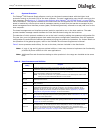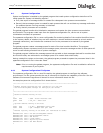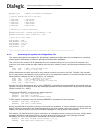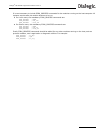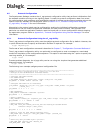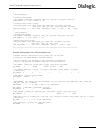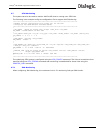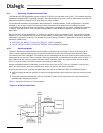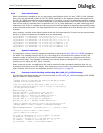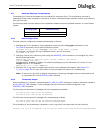
34
4 Dialogic® DSI SS7MD Board Configuration and Operation
4.6 Monitoring
The monitoring option can be used in conjunction with the SS7 Development Package for the appropriate
operating system (Linux or Solaris) to realize a high-performance protocol monitor with up to 4 boards, each
monitoring a certain number of links (see the table in Section 2.3.1, “Run Modes” on page 15 for details).
When used in a passive monitoring mode, the DSI SS7MD Boards treat the signaling timeslot as an HDLC
channel so, in addition to SS7, other flag-idle HDLC-based protocols may be monitored, for example LAPB,
Q.931 (ISDN PRI) and DPNSS. The protocol to be monitored must have a minimum frame length (excluding
flags) of 5 octets, a maximum of 278 octets, and use the CRC polynomial (x
16
+ x
12
+ x
5
+ 1). When
operating in monitoring mode, the 3rd and successive identical frames may be filtered.
It is possible to configure monitoring and terminated SS7 links on the same signaling card.
4.6.1 Configuration
The user needs to set up the configuration for the T1/E1/J1 interface and the operating parameters for each
link to be monitored. This can be achieved using the config.txt file in conjunction with the s7_mgt configuration
utility. Users wishing to use discrete message-based configuration should refer to Section A.2, “Monitoring
Configuration Using Individual Messages” on page 180 of this manual.
4.6.2 Runtime Operations
Once configured, whenever a frame is received, it is reported to the user’s application as an
API_MSG_RX_IND or API_MSG_RX_INDT (timestamped) message.
During operation, the user may also read (and optionally reset) various statistics on a per-link basis by
sending a Link Statistics Request (DVR_MSG_R_L1_STATS) message.




